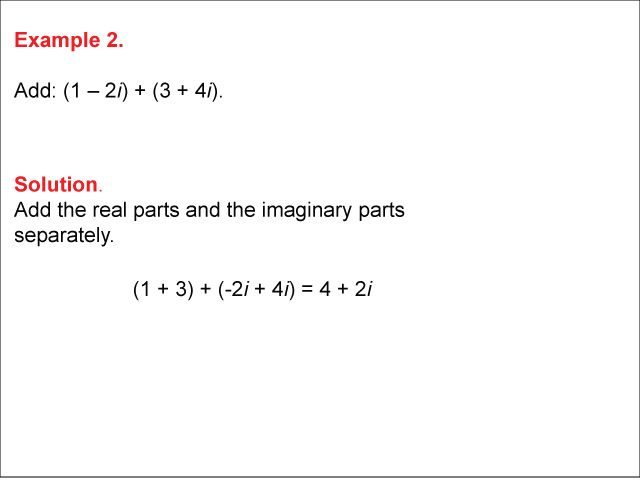
Display Title
Math Example--Complex Numbers--Adding and Subtracting Complex Numbers--Example 2
Display Title
Math Example--Complex Numbers--Adding and Subtracting Complex Numbers--Example 2

Topic
Complex Numbers
Description
The image shows a math example on adding complex numbers. The problem is (1 - 2i) + (3 + 4i). The real and imaginary parts are added separately. The example showcases how to calculate the sum or difference between two complex numbers.
In general, understanding complex numbers is a fundamental part of advanced mathematics, as they allow for a broader comprehension of numbers beyond the real number line. This example and others in this collection provide step-by-step illustrations of adding and subtracting complex numbers, emphasizing the importance of treating real and imaginary components separately.
Seeing multiple worked-out examples is crucial for students to fully understand the concept of complex number operations. By viewing different scenarios, such as adding or subtracting numbers with positive and negative imaginary parts, students build a solid foundation in handling these numbers confidently.
Teacher’s Script: Let's look at this example together. Notice how we add the real parts and the imaginary parts separately. Complex numbers may look intimidating, but with practice, you'll see they follow clear patterns. How would you handle the next example based on what we've discussed?
For a complete collection of math examples related to Complex Numbers click on this link: Math Examples: Adding and Subtracting Complex Numbers Collection.
| Common Core Standards | CCSS.MATH.CONTENT.HSN.CN.A.1, CCSS.MATH.CONTENT.HSN.CN.A.2, CCSS.MATH.CONTENT.HSN.CN.A.3 |
|---|---|
| Grade Range | 9 - 12 |
| Curriculum Nodes |
Algebra • Expressions, Equations, and Inequalities • Numerical and Algebraic Expressions |
| Copyright Year | 2020 |
| Keywords | complex numbers, adding and subtracting complex numbers |